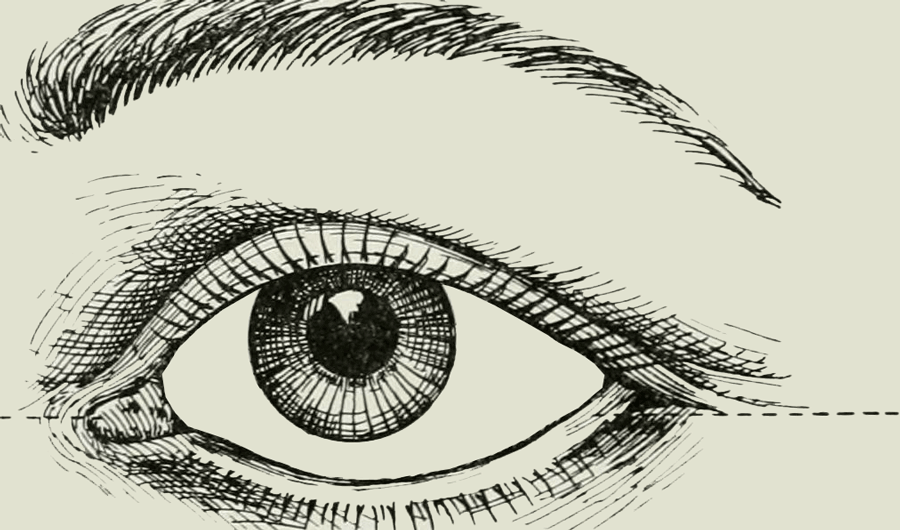Another Pair of Eyes Does See Different Things

Taken from "The American encyclopedia and dictionary of ophthalmology," published in 1913.
Animated by Yuen Yiu.
(Inside Science) -- If a picture is worth a thousand words, scientists now find that not everybody looks at the same words first. When shown a series of pictures some people might focus more on, say, faces, while others might fixate on food. The new findings emphasize how the world might look different from one person to the next.
Much remains a mystery about how we look at the world. People constantly move their eyes to fix their gazes on items of interest, making about two to four eye movements every second for some 150,000 motions daily, but it remains uncertain how we choose what to focus on.
Scientists attempting to predict which parts of a scene will attract the eye have often tried modeling a "typical observer" based on aggregated data from many people. A common assumption was that any differences between the gazes of people could "safely be ignored," said study lead author Benjamin de Haas, a neuroscientist at Justus-Liebig University Giessen in Germany.
To investigate how much gaze might vary between people, the researchers had more than 100 adult volunteers seated at computers look at 700 pictures depicting everyday scenes with a variety of items. At the same time, cameras, pointed at the eyes of those participants, helped track their gazes to deduce what they were looking at in each picture.
"There's no way for me to climb in your head and know what pistachio ice cream tastes to you, but eye movements at least draw some boundary conditions on how your experience of the world may differ from mine," de Haas said.
The scientists found that certain types of details, such as faces, text, food, moving objects or touched items, attracted the gazes of some observers more than others. For example, the fraction of a person's eye movements directed toward faces varied from 17% to 43% among the volunteers. In other words, "the individual tendency to look at faces or text can vary more than twofold from one person to the next," de Haas said.
Such trends also proved to be highly consistent -- even when volunteers were called back for follow-up sessions two weeks afterward. "Knowing the individual tendencies for one set of images could explain almost three-quarters of the looking tendencies for another," de Haas said. "This implies the way we look at images is personal. What you see can be different from what I'm seeing, even if we look at exactly the same images."
Often times, "the human is treated as a passive device whose attention can be captured by the image," said vision scientist Mary Hayhoe at the University of Texas at Austin, who did not take part in this research. This work emphasizes that "in reality, humans are active seekers of information."
The researchers suggested these differences in gaze might have some genetic foundations. For example, they noted that two recent studies from the United States and Sweden found that identical twins had far more similar patterns of eye movements than fraternal twins did.
Previous research has found other biological differences in gaze behavior. "Marmosets apparently love looking at faces on computer screens, but macaques won't, because they consider looking at the face a hostile gesture," Hayhoe said.
Still, prior work has also shown "that culture can shape our gaze behavior as well," de Haas said. For example, a previous study found that Westerners tend to look at specific features on a person's face such as the eyes and mouth, whereas East Asians often focus on the nose or the center of the face, which allows a more general view of all the features, a difference that the researchers suggested may reflect a Western focus on the individual and an Eastern leaning toward the group.
"I do feel these differences likely reflect learned behaviors," Hayhoe said. "More data is needed to say anything about the biological roots of these differences."
The scientists now plan to explore what impact these differences may or may not have in the real world. "Let's say your eyes have a particular tendency to be attracted by text," de Haas said. "Does that mean you're more easily distracted when driving past a billboard?"
These findings suggest that eye-tracking might help reveal new ways to diagnose disorders such as autism, in which people tend to gaze at faces and social cues differently, the researchers said. "The earlier one can pick up on the fact that children are autistic, the earlier one can start them on therapy and training programs, which can prove terrifically important," Hayhoe said.
The scientists detailed their findings online May 28 in the journal Proceedings of the National Academy of Sciences.

